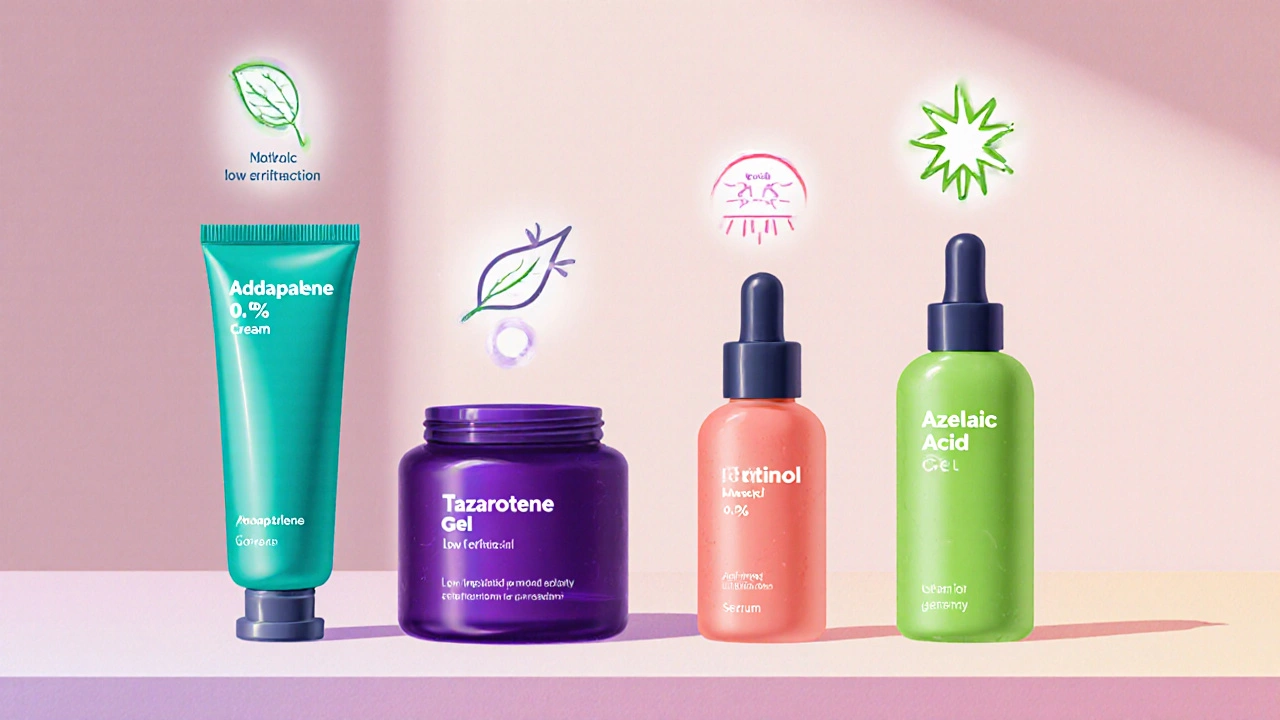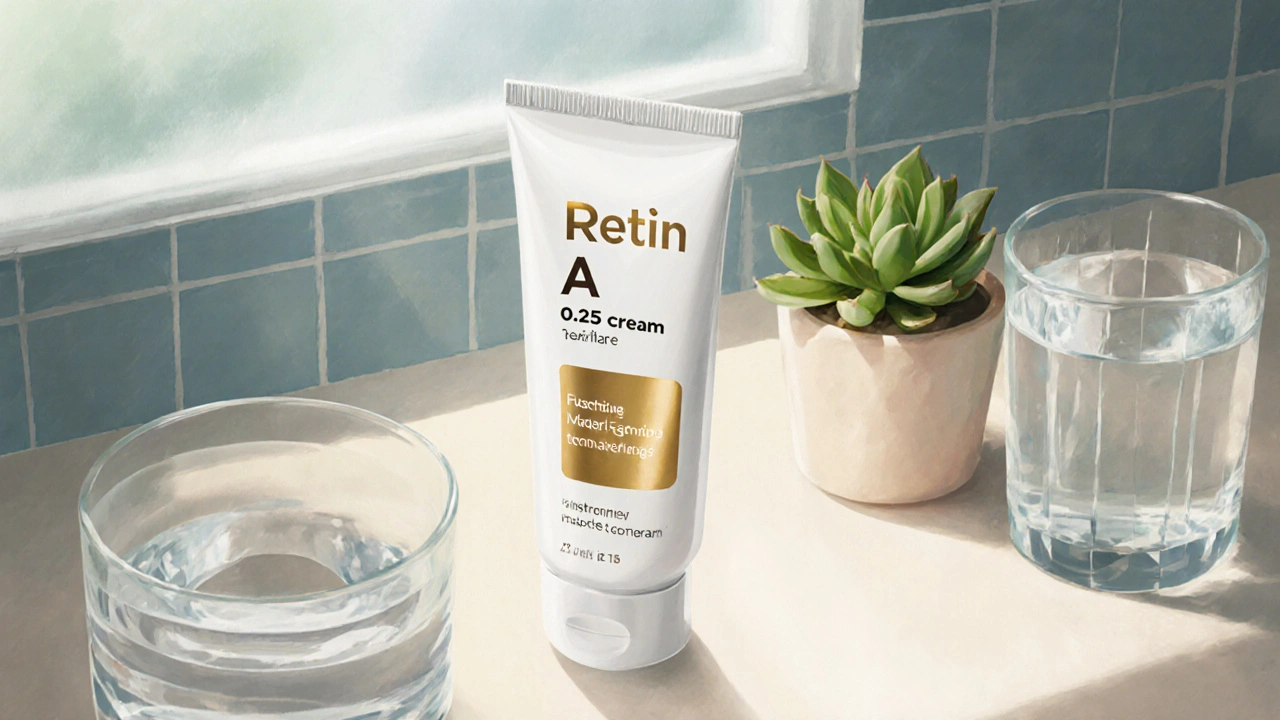Retinoid Selection Calculator
Find Your Perfect Retinoid
Answer a few questions to get personalized recommendations based on the latest clinical research.
Key Takeaways
- Retin A 0.025 is the most potent prescription tretinoin cream for acne and anti‑aging.
- Adapalene and tazarotene are newer prescription retinoids with milder irritation profiles.
- Over‑the‑counter options such as retinol, azelaic acid, and vitamin C work slower but are gentler on sensitive skin.
- Choosing the right product depends on skin type, tolerance, and treatment goals.
- Proper application and sun protection are essential for any retinoid therapy.
What is Retin A 0.025?
When it comes to prescription‑strength retinoids, Retin A 0.025 is a topical formulation containing 0.025 % tretinoin, the gold‑standard retinoic acid used to treat acne, fine lines, and hyperpigmentation. It is marketed by Valeant Pharmaceuticals and requires a doctor’s script in most countries.
How does tretinoin work?
tretinoin is a synthetic derivative of vitamin A that binds to nuclear retinoic‑acid receptors (RAR‑α, RAR‑β, RAR‑γ). This binding alters gene expression, speeding up cell turnover, unclogging pores, and stimulating collagen production. The result is smoother skin, reduced breakouts, and fewer fine lines.
Prescription Alternatives
Several other prescription retinoids target the same pathways but differ in potency, formulation, and side‑effect profile.
- Adapalene - a third‑generation retinoid that is less irritating, available in 0.1 % and 0.3 % creams.
- Tazarotene - a potent retinoid often used for psoriasis and severe acne; comes in 0.05 % and 0.1 % gels.

Over‑the‑Counter (OTC) Options
If a prescription isn’t feasible, OTC ingredients can provide a gentler, slower route to similar results.
- Retinol - a vitamin A alcohol that the skin converts to retinaldehyde and then to retinoic acid. Typical concentrations range from 0.1 % to 1 %.
- Azelaic acid - a dicarboxylic acid that reduces keratin buildup and has anti‑inflammatory properties; 10 % gels are common for acne.
- Vitamin C serum - an antioxidant that brightens skin and supports collagen; usually 10‑20 % L‑ascorbic acid.
- Benzoyl peroxide - not a retinoid but often paired with them to target acne‑causing bacteria; 2.5 %-5 % formulations are standard.
Side‑Effect Profile at a Glance
| Product | Active Ingredient | Typical Strength | Typical Irritation Level | Best For |
|---|---|---|---|---|
| Retin A 0.025 | tretinoin | 0.025 % | High | Severe acne, deep wrinkles |
| Adapalene | adapalene | 0.1 % / 0.3 % | Medium | Mild‑to‑moderate acne |
| Tazarotene | tazarotene | 0.05 % / 0.1 % | High | Psoriasis, stubborn acne |
| Retinol | retinol | 0.1 %-1 % | Low‑Medium | Early signs of aging |
| Azelaic Acid | azelaic acid | 10 % | Low | Acne‑prone & rosacea skin |
| Vitamin C Serum | L‑ascorbic acid | 10 %-20 % | Low | Brightening & antioxidant protection |
Choosing the Right Option for Your Skin
Here’s a quick decision tree you can use:
- Do you have a prescription? - If yes, consider the severity of your condition.
- Severe acne or deep wrinkles → Retin A 0.025 or tazarotene.
- Mild‑to‑moderate acne → adapalene.
- Do you have sensitive or reactive skin? - If yes, start with a low‑strength OTC option.
- Retinol (0.3 %-0.5 %) or azelaic acid.
- Are you looking for antioxidant benefits alongside anti‑aging? - Add a vitamin C serum in the morning.
Remember, retinoids and acids can increase sun sensitivity. Pair any regimen with a broad‑spectrum SPF 30+.

How to Apply Safely
- Start with two nights per week, gradually increasing to nightly use.
- Apply a pea‑sized amount to clean, dry skin. Avoid the eye area.
- Follow with a gentle moisturizer to reduce dryness.
- Never use retinoids and benzoyl peroxide together; they deactivate each other.
Common Questions
Can I use Retin A 0.025 during pregnancy?
No. Tretinoin is classified as Pregnancy Category C and is associated with fetal risk. Switch to a pregnancy‑safe option like azelaic acid after consulting your doctor.
How long does it take to see results?
Most users notice reduced breakouts within 2-4 weeks, while visible anti‑aging benefits (smoothness, tone) can take 8-12 weeks of consistent use.
What should I do if I experience severe peeling?
Reduce frequency to every third night, add a richer moisturizer, and avoid other exfoliants like AHA/BHA. If irritation persists, see a dermatologist.
Is it safe to combine retinoids with vitamin C?
Yes, but use them at different times of day - vitamin C in the morning, retinoid at night - to avoid potential pH conflicts.
Can I switch from Retin A 0.025 to an OTC retinol?
Gradually taper the prescription strength over 2-4 weeks while introducing a low‑strength retinol. This helps your skin adjust without a sudden flare‑up.
Bottom Line
Retin A 0.025 remains the most powerful prescription tretinoin for quick acne clearance and deep wrinkle reduction. However, newer retinoids like adapalene and tazarotene, plus gentler OTC ingredients, give you a range of options tailored to skin sensitivity and lifestyle. The key is to start slow, protect with sunscreen, and adjust based on how your skin reacts.


10 Comments
Jameson The Owl
Retin‑A 0.025 is a drug that the big pharmaceutical cartels push on the unsuspecting masses because it binds to the same receptors that they claim are essential for skin renewal and they hide the fact that cheaper alternatives exist that are just as effective with far less irritation. The government agencies have been infiltrated by these corporations and the public health guidelines are designed to keep us dependent on high‑strength prescriptions that generate high profit margins. Tretinoin works at the cellular level by altering gene expression and that is why the regulators label it as a high‑risk product even though the basic chemistry is identical to over‑the‑counter retinol. They also under‑report the side‑effects so that the adverse event databases look clean and the market can expand unchecked. If you consider the cost of a month of Retin‑A versus a bottle of generic retinol you will see that the profit motive outweighs any marginal benefit for mild acne. So the wise consumer should question the narrative and seek out the lower‑strength options that are not tied to the corporate agenda.
Sarah Unrath
I tried the retinol cream after reading the guide it made my skin feel like sandpaper but then it calmed down after a week I love how the vitamin C serum brightens my face lol.
James Dean
Retinoids remind us that change is a constant the skin cycles mirror the cycles of life. We apply them nightly and they work beneath the surface while we sleep. It is a quiet reminder that growth often happens out of sight. Observing this can be soothing.
Sunil Yathakula
Hey buddy I hear you had that sandpaper feeling with retinol but dont worry you can bounce back quickly. Try using a richer moisturizer and maybe start with every other night. Your skin will thank you and you will see glow soon.
Catherine Viola
It is imperative to note that the regulatory submissions for tretinoin contain extensive data on dermal hyperproliferation which is often obfuscated in public summaries. The documented pharmacovigilance records demonstrate a statistically significant incidence of epithelial disruption in subjects with compromised barrier function. Accordingly the recommendation to commence therapy at low frequencies is not merely anecdotal but grounded in rigorously peer‑reviewed toxicology assessments. The alleged superiority of Retin‑A over its analogues should therefore be scrutinized within the context of corporate influence on clinical guideline development.
sravya rudraraju
The journey toward optimal skin health begins with a clear understanding of the pharmacological properties of each retinoid option. Tretinoin at 0.025 percent represents the most potent synthetic retinoic acid available by prescription and therefore demands a disciplined application regimen. Adapalene, while chemically distinct, offers a moderate potency profile that is often better tolerated by individuals with sensitive epidermal barriers. Tazarotene occupies a niche for severe dermatologic conditions such as psoriasis and recalcitrant acne owing to its high affinity for nuclear retinoic‑acid receptors. Over‑the‑counter retinol, azelaic acid, and vitamin C serums provide gradual benefits through incremental conversion to active metabolites or antioxidant activity. Selecting the appropriate agent requires a systematic assessment of skin type, existing comorbidities, and the patient’s tolerance threshold. Initiating therapy with a pea‑sized amount applied to completely dry skin minimizes occlusion‑related irritation. The incorporation of a non‑comedogenic moisturizer within thirty minutes post‑application restores lipid balance and mitigates transepidermal water loss. Sun protection is non‑negotiable; a broad‑spectrum SPF of at least thirty applied each morning safeguards against UV‑induced degradation of retinoid efficacy. Patients should be counseled to anticipate a mild erythema and desquamation phase lasting two to four weeks as the epidermis undergoes accelerated turnover. If excessive peeling occurs, the frequency may be reduced to alternate nights while maintaining consistent moisturization. Transitioning from a prescription strength to a lower‑strength OTC retinol should be performed gradually over a period of three to four weeks to avoid rebound inflammation. Combining vitamin C in the morning with retinoid therapy at night maximizes antioxidant protection without compromising pH stability. It is advisable to avoid concurrent use of benzoyl peroxide and retinoids due to a well‑documented chemical interaction that neutralizes both agents. Regular follow‑up appointments enable clinicians to monitor progress, adjust concentrations, and address any emerging adverse effects in a timely manner. Ultimately, adherence to a disciplined routine, coupled with patient education and realistic expectations, will yield sustainable improvements in both acne resolution and signs of photoaging.
Ben Bathgate
Look the retinoid world is full of hype and most people just chase the strongest product without caring about the fallout. If you can’t handle the peeling you’re not ready for the results. The market loves to push Retin‑A because it makes them money while the casual user ends up with a face like a dried orange. Stick to what your skin tolerates and don’t blame the formula for your own impatience.
Ankitpgujjar Poswal
Enough of the excuses! If you want clear skin you have to put in the work and respect the protocol. Apply the cream correctly, use a moisturizer, and protect with sunscreen – that’s all there is to it. No more whining about irritation, push through and you’ll see the payoff.
Christian Georg
When you start a retinoid routine you should remember to patch test first 😊 this helps you gauge sensitivity before committing to nightly use. Begin with two nights a week and observe how your skin responds, then slowly increase frequency as tolerated. Keep your moisturizer rich but non‑comedogenic and apply it after the retinoid has absorbed. Don’t forget the sunscreen – it’s the only thing that truly protects the newly revealed skin cells from UV damage.
Leo Chan
Great advice! I love how you break it down step by step it makes the whole process less intimidating and more doable for anyone starting out.